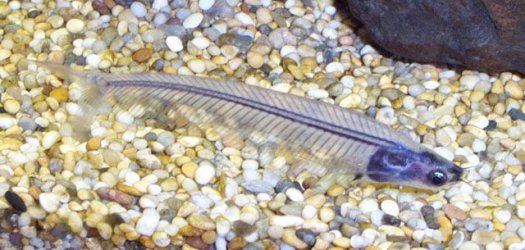Phantom Thief
Population Control Volunteer
Common name/s: Glass Catfish, Ghost Catfish, Asian Glass Catfish
Scientific name: Kryptopterus minor
Family: Siluridae
Origin: Southeast Asia
Maximum size: 4"
Care: These fish can be rather sensitive to water conditions, and thus a matured tank is required. When stocking this fish, put it in last. Soft and acidic water is needed. Nitrate levels must be kept below 40ppm. Plants are important to make this fish feel secure, or they may be extremely skittish. They can be put with pretty much any other community fish, since it is very peaceful. Be careful that there are no fish disturbing it, however, as it is easily stressed. Also, they must be kept in groups of at least 3-4, as keeping too few of this species will make it feel very insecure and stressed, and it will eventually perish.
Feeding: Live foods such as bloodworms are preferred. They may take prepared food, but only do so when the food is moved by a water current, or sinking. Mine never go to the top to feed.
Sexing and breeding Unknown
Comments: The glass catfish can turn a milky colour when stressed. When i first bought mine, one of them turned white. It died the next day. The others, who remained translucent, survived till today. Mine hang out at a single spot in the tank all day, and when i redecorate the tank, they simply pick another spot and stay there all day. An important point to note is that there is another species of glass catfish which is similar, but not the same. Parailia pellucida is the other species, and the difference lies in the spine. Kryptopterus minor has a translucent spine, while parailia pellucida's spine is an opaque black.
Mod. Comment: Another area of confusion is between K. minor and K. bicirrhis. There are small differences between the two, the easiest of which to tell the difference is size. K. bicirrhis is larger than K. minor. Both inhabit the same environment.
Credit goes to Bunjiweb for the picture of this Glass Catfish

Scientific name: Kryptopterus minor
Family: Siluridae
Origin: Southeast Asia
Maximum size: 4"
Care: These fish can be rather sensitive to water conditions, and thus a matured tank is required. When stocking this fish, put it in last. Soft and acidic water is needed. Nitrate levels must be kept below 40ppm. Plants are important to make this fish feel secure, or they may be extremely skittish. They can be put with pretty much any other community fish, since it is very peaceful. Be careful that there are no fish disturbing it, however, as it is easily stressed. Also, they must be kept in groups of at least 3-4, as keeping too few of this species will make it feel very insecure and stressed, and it will eventually perish.
Feeding: Live foods such as bloodworms are preferred. They may take prepared food, but only do so when the food is moved by a water current, or sinking. Mine never go to the top to feed.
Sexing and breeding Unknown
Comments: The glass catfish can turn a milky colour when stressed. When i first bought mine, one of them turned white. It died the next day. The others, who remained translucent, survived till today. Mine hang out at a single spot in the tank all day, and when i redecorate the tank, they simply pick another spot and stay there all day. An important point to note is that there is another species of glass catfish which is similar, but not the same. Parailia pellucida is the other species, and the difference lies in the spine. Kryptopterus minor has a translucent spine, while parailia pellucida's spine is an opaque black.
Mod. Comment: Another area of confusion is between K. minor and K. bicirrhis. There are small differences between the two, the easiest of which to tell the difference is size. K. bicirrhis is larger than K. minor. Both inhabit the same environment.
Credit goes to Bunjiweb for the picture of this Glass Catfish




